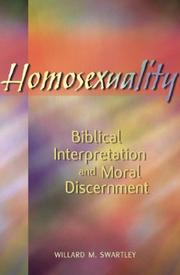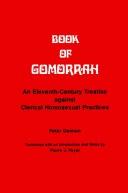| Listing 1 - 10 of 10 |
Sort by
|
Book
ISBN: 0761843183 9780761843184 Year: 2009 Publisher: Lanham University press of America
Abstract | Keywords | Export | Availability | Bookmark
 Loading...
Loading...Choose an application
- Reference Manager
- EndNote
- RefWorks (Direct export to RefWorks)
Bible and homosexuality --- Love --- Same-sex marriage --- Religious aspects --- Christianity

ISBN: 080062985X Year: 1998 Publisher: Minneapolis (Minn.): Fortress
Abstract | Keywords | Export | Availability | Bookmark
 Loading...
Loading...Choose an application
- Reference Manager
- EndNote
- RefWorks (Direct export to RefWorks)
Surveys attitudes in the ancient world toward homoeroticism, that is, erotic same-sex relations, focusing on the Bible and its cultural environment -- Mesopotamia, Greece, Rome, Israel. Homoeroticism is examined as a part of gender identity, i.e., the interplay of sexual orientation, gender identification, gender roles, and sexual practice. In the patriarchal cultures of the biblical world, Nissinen shows, homoerotic practices were regarded as a role construction between the active and passive partners rather than as expressions of an orientation moderns call "homosexuality." Nissinen shows how this applies to the limited acceptance of homoerotic relationships in Greek and Roman culture, as well as to Israel's and the early church's condemnation of any same-sex erotic activity. (Augsburg Fortress)
Bible and homosexuality --- Homosexuality in the Bible --- Homosexuality --- History

ISBN: 0585462674 9780585462677 0836192451 9780836192452 Year: 2003 Publisher: Scottdale, Pa. Herald Press
Abstract | Keywords | Export | Availability | Bookmark
 Loading...
Loading...Choose an application
- Reference Manager
- EndNote
- RefWorks (Direct export to RefWorks)
Homosexuality --- Bible and homosexuality --- Homosexuality and the Bible --- Religious aspects --- Mennonites. --- Biblical teaching. --- Doctrines --- Doctrines.
Book
ISBN: 9780802868633 Year: 2013 Publisher: Grand Rapids Eerdmans
Abstract | Keywords | Export | Availability | Bookmark
 Loading...
Loading...Choose an application
- Reference Manager
- EndNote
- RefWorks (Direct export to RefWorks)
Bible and homosexuality --- Homosexuality --- Marriage --- Sex --- Religious aspects --- Christianity --- Biblical teaching
Book
ISBN: 066423397X 9780664233976 Year: 2009 Publisher: Louisville, Ky. Westminster John Knox Press
Abstract | Keywords | Export | Availability | Bookmark
 Loading...
Loading...Choose an application
- Reference Manager
- EndNote
- RefWorks (Direct export to RefWorks)
Bible and homosexuality --- Homosexuality --- Religious aspects --- Presbyterian Church (U.S.A.) --- Doctrines.
Book
ISBN: 9780830785674 0830785671 9780830785773 Year: 2023 Publisher: Colorado Springs, CO David C. Cook
Abstract | Keywords | Export | Availability | Bookmark
 Loading...
Loading...Choose an application
- Reference Manager
- EndNote
- RefWorks (Direct export to RefWorks)
Bible and homosexuality --- Marriage --- Sex --- Same-sex marriage --- Biblical teaching --- Religious aspects --- Christianity
Book
ISBN: 9781628374124 1628374128 Year: 2021 Publisher: Atlanta (Ga.) : SBL Press,
Abstract | Keywords | Export | Availability | Bookmark
 Loading...
Loading...Choose an application
- Reference Manager
- EndNote
- RefWorks (Direct export to RefWorks)
In Feminism, Queerness, Affect, and Romans: Under God? Jimmy Hoke reads Romans with an innovative, intersectional approach that produces distinctive meanings for passages that probe how queer wo/men who first encountered Paul's letter could have engaged with it. Though Paul's letter to the Romans arguably contains the Bible's strongest condemnation of queer wo/men (1:26-27), that is not the letter's full story. Hoke turns a feminist and queer gaze toward Paul's conception of faith and ethics, making explicit how Paul's theology throughout Romans has been affectively motivated by imperial notions of gender, race, and sexuality. Moving beyond Paul's singular voice, Hoke engages with a feminist and queer praxis of assemblage to generate plausible ways wo/men of Rome interacted with this epistle. By engaging affect theory, Hoke brings to life not only ideas and words but the feelings and sensations that moved in-between some of the earliest Christ-followers, revealing how queer wo/men were there among them and what that means for queer wo/men today. Hoke includes a reader's guide with key terms used throughout the book, making this an excellent option for both students and scholars beginning to engage not only Paul's letters but also the complex worlds of feminist, queer, and affect theories--Page 4 of cover.
Bible and homosexuality. --- Bible et homosexualité. --- Homosexuality --- Homosexualité --- Biblical teaching. --- Enseignement biblique. --- Bible. --- Criticism, interpretation, etc. --- Gay interpretations.
Book
ISSN: 05882257 ISBN: 9782204083362 2204083364 Year: 2007 Volume: 147 Publisher: Paris: Cerf,
Abstract | Keywords | Export | Availability | Bookmark
 Loading...
Loading...Choose an application
- Reference Manager
- EndNote
- RefWorks (Direct export to RefWorks)
La Bible parle-t-elle de l'homosexualité ? Très peu ! Trois exégètes chrétiens, deux catholiques et un protestant, relèvent le défi de lire le texte biblique sans tabou ni préjugé et sans recourir à des interprétations personnelles ou ecclésiales. Innocent Himbaza étudie les récits souvent cités dans les discussions sur l'homosexualité comme l'histoire de Sodome (Genèse 19), celle des hommes de Guivéa (Juges 19), l'amour entre Jonathan et David dont l'histoire est racontée dans les livres de Samuel. Adrien Schenker relit les lois du Lévitique (18 et 20) et la règle de conduite qu'elles énoncent en les replaçant dans leur contexte immédiat. Il peut ainsi répondre à la question de savoir pourquoi la pratique de l'amour homosexuel est interdite par la loi de Moïse. Le Nouveau Testament dit-il autre chose que l'Ancien ? Jean-Baptiste Edart étudie les textes de Paul sur les pratiques homosexuelles (Romains 1 ; 1 Corinthiens 6 ; 1 Timothée 1), puis se demande dans quelle mesure les évangiles peuvent intervenir dans le débat. Ce livre, qui n'est pas un traité d'éthique sur l'homosexualité, entend seulement apporter quelques clarifications en montrant la portée de la Bible sur cette question.
Homosexuality in the Bible. --- Bible and homosexuality. --- Homosexualité dans la Bible --- Bible et homosexualité --- Bible --- Criticism, interpretation, etc. --- #GGSB: Moraaltheologie (algemeen) --- #GGSB: Homoseksualiteit --- Homosexuality --- -241.64*32 --- Same-sex attraction --- Sexual orientation --- Bisexuality --- Biblical teaching --- Theologische ethiek: homosexualiteit --- Homosexualité dans la Bible --- Bible et homosexualité --- Bible studies --- Homosexuality. --- Moraaltheologie (algemeen) --- Homoseksualiteit --- -Biblical teaching
Book
ISBN: 9789025612733 9025612733 Year: 2012 Volume: 76 Publisher: Amsterdam: Hakkert,
Abstract | Keywords | Export | Availability | Bookmark
 Loading...
Loading...Choose an application
- Reference Manager
- EndNote
- RefWorks (Direct export to RefWorks)
Historical linguistics --- Fallacies (Logic) --- Akkadian language --- Classical languages --- Akkadian philology --- Classical philology --- Language and culture --- Homophobia in literature --- Bible and homosexuality --- Linguistique historique --- Sophismes --- Akkadien (Langue) --- Langues anciennes --- Philologie akkadienne --- Philologie ancienne --- Langage et culture --- Discrimination à l'égard des homosexuels dans la littérature --- Bible et homosexualité --- Case studies --- Errors of usage --- History --- Cas, Etudes de --- Fautes --- Histoire --- Bible --- Language, style --- Discrimination à l'égard des homosexuels dans la littérature --- Bible et homosexualité --- Case studies. --- Historical linguistics - Case studies --- Fallacies (Logic) - Case studies --- Akkadian language - Errors of usage - Case studies --- Classical languages - Errors of usage - Case studies --- Classical philology - History - Case studies --- Language and culture - History - Case studies --- Homophobia in literature - Case studies --- Bible and homosexuality - Case studies --- Language, style.

ISBN: 0889201234 0889208425 9780889208421 1554586631 9780889201231 Year: 1982 Publisher: Waterloo, Ont., Canada : Wilfrid Laurier University Press,
Abstract | Keywords | Export | Availability | Bookmark
 Loading...
Loading...Choose an application
- Reference Manager
- EndNote
- RefWorks (Direct export to RefWorks)
Some of the roots of a negative attitude to homosexuality are found in Peter Damian’s appeal to Pope Leo IX. Written 900 years ago by an Italian monk, The Book of Gomorrah asks the Pope to take steps to halt the spread of homosexual practices among the clergy and is relevant to contemporary discussion of homosexuality. The Book of Gomorrah asks the Pope to take steps to halt the spread of homosexual practices among the clergy. The first part outlines the various forms of homosexual practice, the specific abuses, and the inadequacy of traditional penitential penances, and demands that offenders be removed form their ecclesiastical positions. The second part is an impassioned plea to the offenders to repent of their ways, accept due penance, and cease from homosexual activity. Payer’s is the first translation of the full tract into any language from the original Latin. In his introduction to the tract Payer places The Book of Gomorrah in its context as the first major systematic treatise in the medieval West against various homosexual acts, provides a critique of Peter Damian’s arguments, and outlines his life. The annotated translation is followed by a translation of the letter of Pope Leo IX in reply to Damian’s Treatise, an extensive bibliography, and indexes. The book will be of interest to students of medieval history and religion, to ethicists and students of social mores, and to persons generally concerned with the historical roots of present-day attitudes to homosexuality.
Homosexuality --- Gay clergy --- Religious aspects --- Catholic Church --- Clergy --- Sexual behavior --- -Same-sex attraction --- Sexual orientation --- Bisexuality --- -Catholic Church --- -Church of Rome --- Roman Catholic Church --- Katholische Kirche --- Katolyt︠s︡ʹka t︠s︡erkva --- Römisch-Katholische Kirche --- Römische Kirche --- Ecclesia Catholica --- Eglise catholique --- Eglise catholique-romaine --- Katolicheskai︠a︡ t︠s︡erkovʹ --- Chiesa cattolica --- Iglesia Católica --- Kościół Katolicki --- Katolicki Kościół --- Kościół Rzymskokatolicki --- Nihon Katorikku Kyōkai --- Katholikē Ekklēsia --- Gereja Katolik --- Kenesiyah ha-Ḳatolit --- Kanisa Katoliki --- כנסיה הקתולית --- כנסייה הקתולית --- 가톨릭교 --- 천주교 --- -Sexual behavior --- Gay clergy. --- Catholic Church. --- Sexual behavior. --- -Religious aspects --- -Clergy --- Same-sex attraction --- Religious aspects&delete& --- Church of Rome --- Homosexuality - Religious aspects - Catholic Church --- bible and homosexuality. --- biblical understanding of homosexuality. --- christian and gay. --- clerics. --- gay priests. --- gomorrah. --- homosexuality. --- lgbtq and religion. --- medieval. --- priests. --- queer priests. --- religious and gay.
| Listing 1 - 10 of 10 |
Sort by
|

 Search
Search Feedback
Feedback About UniCat
About UniCat  Help
Help News
News